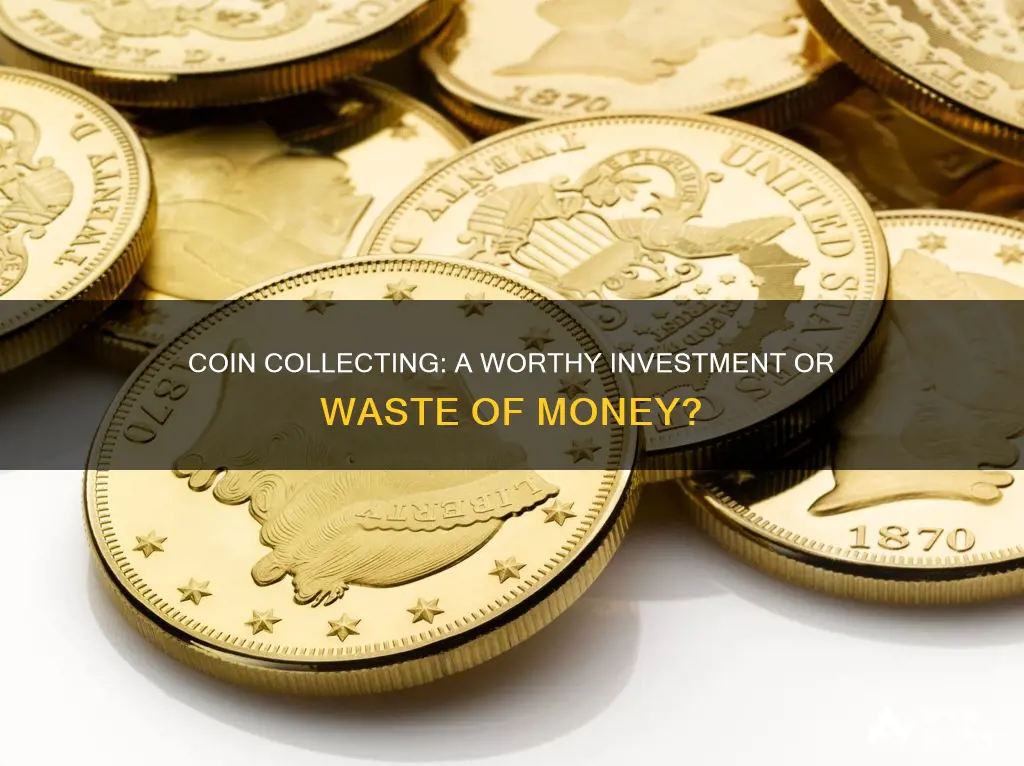
Coin collecting is a fun hobby for many, but it can also be a profitable investment venture. The value of a coin is derived from its bullion value, or the precious metal it is made of, and its collector or numismatic value, which applies mostly to antique and rare coins. Rare coins are generally a non-volatile asset type that can add diversity to a portfolio, but they are not ideal for short-term profits. Coin prices depend on supply and demand, and the market can be volatile. Coins are not like shares of stock; each coin is unique, even if it is of the same type and grade as another.
What You'll Learn

Rare coins can be a profitable long-term investment
Coin collecting is a fun hobby that allows people to engage with history and hunt for hard-to-get coins. But it can also be a profitable investment strategy when approached in the right way.
Coins derive their value from two main sources. The first is the bullion value, or the physical metal contained in the coin. As many collectible coins are made from precious metals like gold or silver, they have intrinsic value as stores of these metals. The bullion value can be calculated by multiplying the number of ounces of metal in a coin by the spot price per ounce of that metal.
The second source of value is the collector or numismatic value, which applies mostly to antique and rare coins. This value is influenced by factors such as scarcity, condition, and buyer sentiment. The fewer examples of a coin that were minted, the higher its collector value is likely to be due to limited supply. Coins that are in better condition and closer to uncirculated status also tend to command higher prices from buyers.
Tips for Investing in Rare Coins
When starting a coin collection, it's advisable to focus initially on bullion value. Investing in modern bullion coins, such as Canadian Maple Leaf silver coins or American Gold Eagles, provides a good entry point into the market. These coins contain high-grade gold or silver, making them excellent precious metal investments, while also being aesthetically pleasing for collectors.
For those interested in the numismatic value of coins, it's important to know which coins will be most in demand among collectors. Rare dates, mint marks, and minting errors can all contribute to a coin's numismatic value. If investing purely for collector value, it's recommended to deal only in certified coins that have been inspected, graded, and certified by recognised organisations.
Additionally, it's worth noting that a coin doesn't have to be extremely expensive to be a good investment based on its numismatic value. For example, the 1950-D Jefferson nickel, with its key date and mint mark pairing, can sell for $70 or more in uncirculated grades, despite its low face and bullion values.
Benefits of Investing in Rare Coins
Rare coins can add diversity to an investment portfolio that is heavily focused on stocks and bonds. They have the potential to provide significant long-term gains, as evidenced by historical price appreciations of elite coins. From 1976 to 1980, prices of elite coins rose more than 1,000%, and from 1982 to 1989, they increased by 600%.
Furthermore, rare coins can be a hedge against market fluctuations. Unlike stocks and shares, the value of rare coins is not tied to market trends but is influenced by factors such as demand, supply, and historical significance. For instance, the Stanley Gibbons GB200 Rare Coin Index, which tracks the value of sought-after British coins, rose by over 6% in a year when the FTSE 100 fell by almost 5%.
Risks and Considerations
While rare coin investing can be profitable, it's important to approach it as a long-term strategy. It takes time to earn significant profits, and the market can be volatile, with coin prices fluctuating based on supply and demand. Additionally, the risk of counterfeit or doctored coins exists, so it's crucial to buy only from reputable dealers and ensure coins are certified by professional grading services.
Strategies Post-Bitcoin Investment: Steps to Take Now
You may want to see also

Coins derive value from their metal and collector's value
Coins derive their value from two main sources. The first is the physical metal they are made of, also known as their bullion value. Many collectible coins are made from precious metals such as gold or silver, which gives them intrinsic value as stores of these metals. The bullion value of a coin can be calculated by multiplying the number of ounces of metal in the coin by the spot price per ounce of that metal at any given time.
The second source of value in a coin is its collector or numismatic value, which applies mostly to antique and rare coins. A coin’s collector value depends on buyer sentiment, but there are some general guidelines. For example, the fewer examples of a coin that were minted, the higher its collector value is likely to be due to limited supply. A coin’s condition also plays a major role in its collector value, with buyers who value coins for their numismatic appeal tending to pay much larger sums for coins that are close to uncirculated condition.
Coins with a high bullion value include modern bullion coins such as Canadian Maple Leaf silver coins and American Gold Eagles, which contain high-grade gold or silver. Some older coins can also be good stores of bullion value, such as American quarters and dimes minted before 1965, which contain 90% silver.
Coins with high numismatic value include those with rare dates and mint marks, as well as coins with rare minting errors. For example, in 2008, the Royal Mint produced 20p mules when the date was moved from the tails to the heads side, accidentally leaving the date off the first batch. About 100,000 of these coins were made, and they now fetch more than £70 each. Another example is a small batch of 2p coins minted in 1983 with the words 'New Pence' instead of 'Two Pence', which can sell for £700.
When investing in rare coins, it is important to be aware of the potential for counterfeit or doctored coins. It is recommended to only buy coins from reputable coin dealers and coins that are certified by professional coin grading services.
Kevin Durant's Coinbase Investment: A Smart Move?
You may want to see also

Numismatics is a lucrative hobby
The bullion value of a coin is determined by the physical metal it contains, such as gold or silver, which gives it intrinsic value. The value can be calculated by multiplying the number of ounces of metal in the coin by the spot price per ounce of that metal. Modern bullion coins, such as Canadian Maple Leaf silver coins and American Gold Eagles, are a great way to invest in precious metals while also collecting attractive coins.
The numismatic or collector value of a coin applies mostly to antique and rare coins. This value is harder to determine as it depends on buyer sentiment. However, factors such as scarcity and the condition of the coin play a major role in its numismatic value. The fewer examples of a coin that were minted and the closer a coin is to uncirculated condition, the higher its collector value is likely to be.
For example, the 1738 King George II Gold Five Guineas piece increased in value by 50% to £45,000, while the 1703 Anne Pre-Union Gold Five Guinea coin rose by £50,000 to £375,000. The most valuable British coin, the Gold Double Leopard from the reign of Edward III in 1344, sold for £460,000 in 2006.
In addition to the potential profits, coin collecting offers a unique connection to history and can be a fun and exciting hobby. It allows individuals to engage with different periods of history and provides the challenge of finding hard-to-get coins.
However, it is important to note that investing in rare coins takes time and may not be suitable for those seeking short-term profits. The market can fluctuate, and it is crucial to be aware of the potential for counterfeit or altered coins.
American Eagle Silver Coins: Smart Investment or Not?
You may want to see also

Modern commemorative coins are not good investments
The value of a coin depends on two main sources: the physical metal contained in the coin, also known as its bullion value, and its collector or numismatic value. Modern commemorative coins often have a higher bullion value due to the precious metals they are made of, such as gold or silver. However, their numismatic value, which applies mostly to antique and rare coins, is harder to determine and depends on buyer sentiment.
The numismatic value of a coin is influenced by factors such as the number of coins minted, with lower mintage numbers leading to higher collector value due to scarce supply. The condition of the coin also plays a significant role, with buyers paying larger sums for coins that are close to uncirculated condition.
Modern commemorative coins, while having a higher bullion value due to their precious metal content, may not have significant numismatic value. They are often mass-produced and not as rare as antique coins, which can make them less desirable to collectors. Additionally, their value may not increase over time, making them a less attractive investment option.
Furthermore, modern commemorative coins are not widely recognised as a form of payment. Shops and banks rarely accept them, which limits their utility as a legal tender. Therefore, if one is considering coin collecting as an investment opportunity, it is advisable to focus on antique and rare coins that have a higher numismatic value and a potential for long-term gains.
Invest in El Salvador's Bitcoin Bond: A Guide
You may want to see also

Grading coins reduces investment risk
Coin grading is a systematic process used to evaluate and assign a standardised grade to a coin based on its condition, wear, and overall state of preservation. The primary purpose of coin grading is to provide a universally accepted and consistent way to communicate a coin’s quality and rarity. This is important as a coin’s grade can have a significant impact on its value. Higher-grade coins are generally more valuable than lower-grade coins, and coins with high grades are often more sought after by collectors and dealers.
The extent of wear on a coin’s surface, particularly on high points or details, directly impacts its grade. Less wear generally results in a higher grade. The original lustre, or shine, of a coin and any toning or discolouration it has acquired over time, also contribute to its overall appearance and, consequently, its grade. The presence of scratches, nicks, or other blemishes on a coin’s surface can lower its grade, as these imperfections affect both aesthetics and preservation.
The Sheldon Scale is a widely recognised grading system, ranging from 1 to 70, with lower numbers indicating more wear and higher numbers representing coins in better condition. The numerical grading system is similar but uses a scale from 1 to 100. The American Numismatic Association (ANA) grading system also uses a scale of 1 to 70, with each grade representing a specific range of conditions.
The process of grading a coin may involve the use of tools such as magnifying glasses to accurately assess tiny details. A magnifying glass allows the grader to see the edges of lettering, the texture of the fields, and any signs of wear or damage.
The benefits of coin grading include providing a standardised and universally recognised indication of a coin’s condition, enhancing its appeal and justifying a higher valuation. Graded coins also instill confidence in buyers, as the certification from reputable grading services assures authenticity and accuracy in assessing a coin’s grade, reducing the uncertainty associated with ungraded coins.
While grading can potentially increase a coin’s value, it is essential to factor in the costs associated with the grading process. Additionally, some collectors place a higher value on coins in their original, unaltered state, as the appeal lies in the coin’s history and authenticity. Therefore, they may not necessarily prioritise graded coins.
Mining Bitcoin with GPUs: Is It Profitable?
You may want to see also
Frequently asked questions
Coin collecting can be a profitable investment venture when done right. Coins derive their value from two primary sources: the physical metal they contain (bullion value) and their collector or numismatic value. Rare coins, in particular, can be a good investment for long-term gains, but they are not ideal for short-term profits.
The value of a coin is influenced by its rarity, condition, and buyer sentiment. The fewer examples of a coin that were minted, the higher its collector value due to limited supply. Additionally, coins that are closer to uncirculated condition tend to command higher prices than those that show signs of regular use.
When starting a coin collection, it is recommended to focus on bullion value. Investing in modern bullion coins, such as Canadian Maple Leaf silver coins or American Gold Eagles, can be a good starting point. These coins contain high-grade gold or silver, making them excellent precious metal investments. It is also important to be aware of potential downsides, such as the time it takes to earn profits and the possibility of counterfeit or altered coins.







